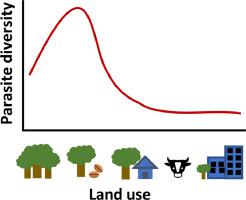Acta Tropica ( IF 2.1 ) Pub Date : 2020-05-26 , DOI: 10.1016/j.actatropica.2020.105542 Carolina Hernández-Lara 1 , Pilar Carbó-Ramírez 1 , Diego Santiago-Alarcon 1

|
Transformation of natural environments for livestock, agriculture and human settlements modifies the diversity of organisms, usually decreasing in highly disturbed land uses. Like their hosts, parasites have to adapt to novel human impacted landscapes, in which the abiotic and biotic conditions are radically different from those of conserved natural environments. We evaluated the diversity (alpha and beta taxonomic and phylogenetic diversity) of haemosporidians (mtDNA cyt b lineages) in the common chlorospingus (Chlorospingus flavopectus) at five land use types. We further analyzed the response of prevalence, parasitaemia and parasite aggregation to land use types and seasonality. Parasite lineage richness (i.e., haplotypes) and abundance (no. infected hosts) decreased with disturbance. Parasite assemblages were commonly dominated by either one of two lineages, one dominant in the urban greenspace (pBAEBIC02) and the other dominant in well-preserved mountain cloud forest (hCHLFLA01). Beta diversity was mainly explained by lineage turnover. Phylo beta diversity was low (i.e., lineages are closely related). Overall prevalence increased in wet season that coincides with host's breeding season. Haemoproteus and Plasmodium prevalence presented the opposite response to urbanization (negative and positive, respectively). Parasitaemia presented similar values across land uses for both genera and seasons, while Plasmodium aggregation decreased with urbanization. Thus, some parasite lineages (pBAEBIC02) will benefit from the urbanization process, while others will entirely disappear from cities (hCHLFLA01).
中文翻译:

土地利用变化(农村-城市)对一只新近传播的鸟类中禽血孢的多样性和流行病学参数的影响。
牲畜,农业和人类住区的自然环境的变化改变了生物的多样性,通常在高度受干扰的土地利用中减少。像它们的寄主一样,寄生虫必须适应人类受到影响的新颖景观,在这些景观中,非生物和生物条件与自然保护环境完全不同。我们评估了常见的绿皮金枪鱼(Chlorospingus flavopectus)中的血孢子虫(mtDNA cyt b谱系)的多样性(alpha和beta分类和系统发育多样性))的五种土地利用类型。我们进一步分析了流行率,寄生虫血症和寄生虫聚集对土地利用类型和季节的响应。寄生虫谱系的丰富度(即单倍型)和丰富度(受感染宿主的数量)随着干扰而降低。寄生虫组合通常由两种谱系之一控制,一种谱系在城市绿地(pBAEBIC02)中占主导,而另一种谱系在保存完好的山云森林(hCHLFLA01)中。Beta多样性主要由血统周转率来解释。Phylo beta多样性很低(即谱系密切相关)。湿季的总体患病率增加,与寄主的繁殖季节相吻合。变形杆菌和疟原虫流行率对城市化的反应相反(分别为负和正)。寄生虫血症在属地和季节的土地利用中呈现出相似的价值,而疟原虫的聚集随着城市化而下降。因此,某些寄生虫谱系(pBAEBIC02)将受益于城市化进程,而其他寄生虫谱系将从城市中完全消失(hCHLFLA01)。











































 京公网安备 11010802027423号
京公网安备 11010802027423号